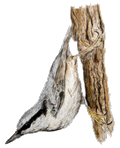
- Sherry Wine:
- Production
- Classification
- Cities & Bodegas
- Tastings
- Analogues
- Authors & Contacts
- Ðóññêèé ñàéò
Sherry analogues
Vin Jaune (yellow wine) from Jura, France
Olga Nikandrova and Denis Shumakov.
Arbois and the vicinities
Vin Jaune (fr. for “yellow wine”) is dry wine made from the Savagnin grape under four AOCs in the French Jura region . Vin jaune is aged under a film of yeast (voile), and this ageing type (biological ageing is the special term) is the only common point of vin jaune and sherry. Nevertheless, this one point is more than enough to express our specific sherry interest in vin jaune.
So, first things first. Jura is a department in eastern France, close to Burgundy and Switzerland (Switzerland — to the east, Burgundy — to the south). Jura is famous for the Jura mountains (with dinosaurs’ footprints and other things which gave a whole period of the Mesozoic Era the name of this department and/or mountains), wonderful cheese (Comté, Morbier, etc) and vin jaune. The latter, of course, is not the only Jurassic wine — only 400-450 thousand bottles of vin jaune are produced yearly with a total annual production of wine in the Jura being 10-12 million bottles. But it is vin jaune that is the hallmark of the region.
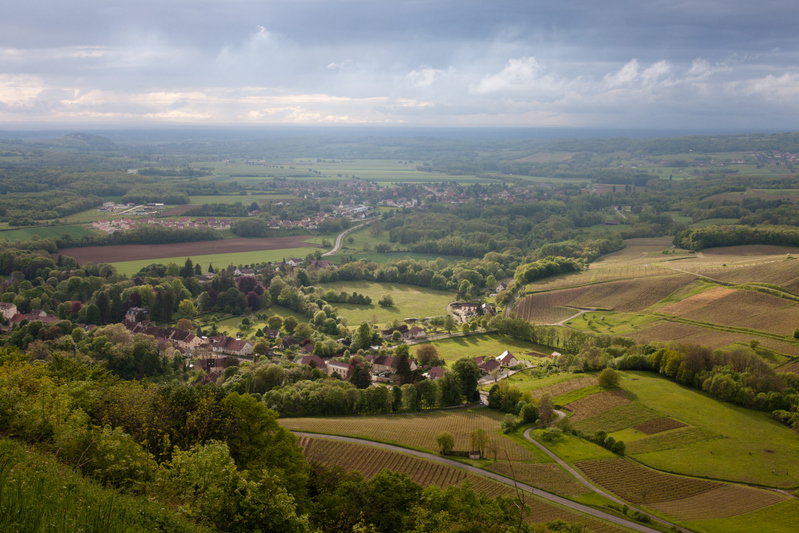
A typical Jura landscape near Château-Chalon. Hereinafter photos by Evgeny Murtola
Climate in Jura is semi-continental with relatively cold winter, warm summer, 1800-1900 annual hours of sunshine a year (not very much, although more than in our home Pskov) and 1000-1500 mm precipitation over the year (and this is quite a lot). Average yearly temperature — about 12°C. Wind is mostly from the South and Southwest, less often — from the North. Soils — marl and limestone. On the whole, vines feel good there, but, of course, some distressing climate events do happen: heavy rains during flowering, frost and summer hail.
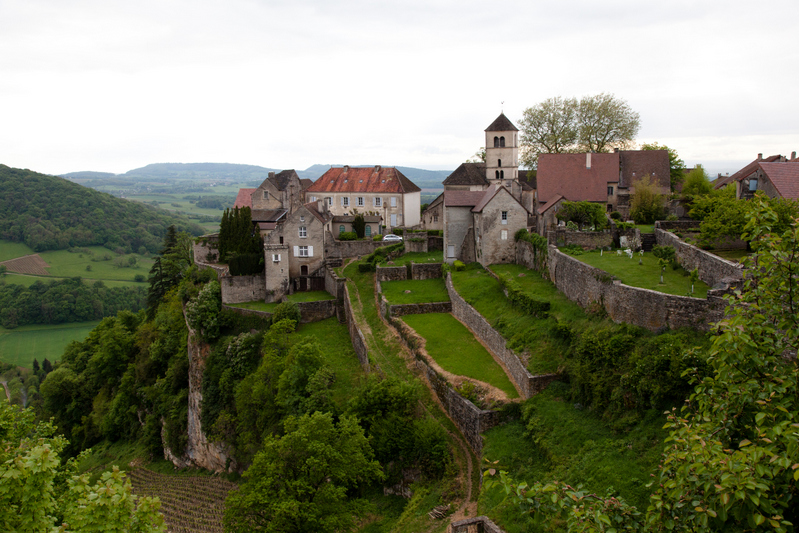
Château-Chalon
There are four AOCs connected with the territory of the department: Château-Chalon, Arbois, l’Etoile and Côtes du Jura. AOC Arbois is the largest in Jura and one of the first France’s AOCs registered in 1936. And the town of Arbois is a wine capital of the Jura region (the administrative capital of the department is Besançon). Three AOCs (Arbois, l’Etoile and Côtes du Jura) produce vin jaune along with other types of wine. But only vin jaune can be labeled as AOC Château-Chalon, its production in Château-Chalon is regulated most strictly — up to skipping wine releases in bad years. If the territory included in AOC Château-Chalon (Château-Chalon itself and several villages in the vicinity) produces some other or not-that-good wine, it is marketed as Côtes du Jura. Naturally, vin jaune from Château-Chalon is considered to be the best.
Under the requirements of the appellation, vin jaune (besides its territorial binding) is the wine produced according to the following rules:
1. Grape variety — Savagnin. This grape is known in Jura since the 13-14th centuries and has always been used for the production of vin jaune. Genetically, Jurassic Savagnin is identical to Traminer from Tyrol. Durable thick-skinned berries, late ripening, high acidity, resistance to traditional grape diseases and characteristic citrus notes in the aroma made Savagnin a very popular grape in Jura — more than 20% of the Jura vineyards are occupied by this variety. By the way, there are several variants of Savagnin (S.Vert, S.Jaune, S.Muscaté and so on) and, of course, not only vin jaune is made from this grape.
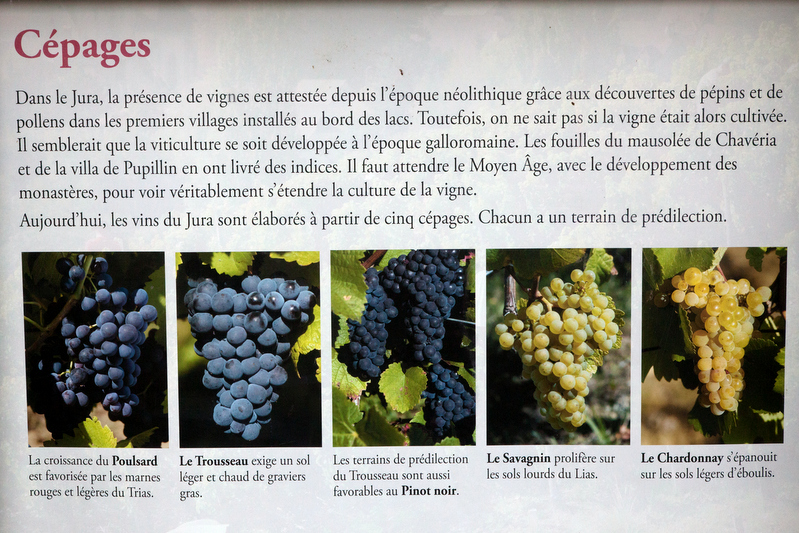
Grape varieties grown in Jura
Savagnin intended for the production of vin jaune is harvested late, but not too late — botritization is rarely allowed. First, dry white wine is made from this grape, then it is fermented in stainless steel tanks (usually) or in oak barrels (less often). Optimal characteristics of the wine intended for further maturation are 13% abv and relatively high acidity (pH 3,0-3,1). Before being poured into barrels for maturation, vin-jaune-to-be should rest and get rid of carbon dioxide surpluses.
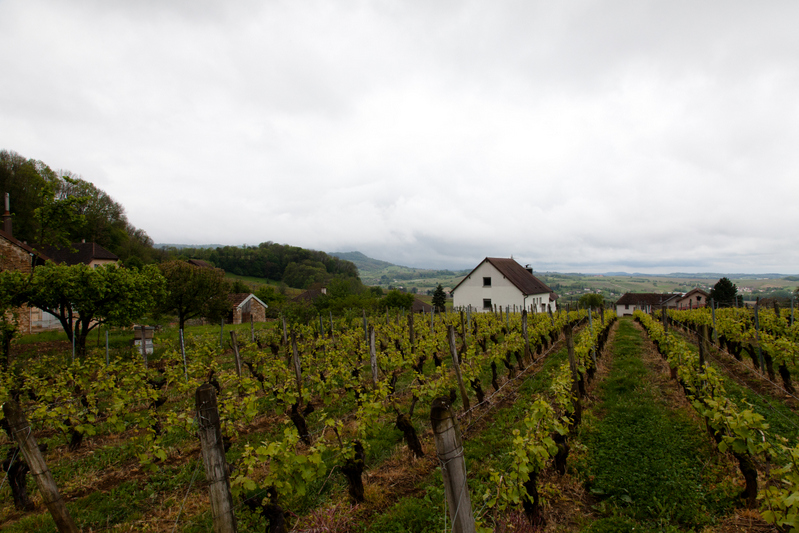
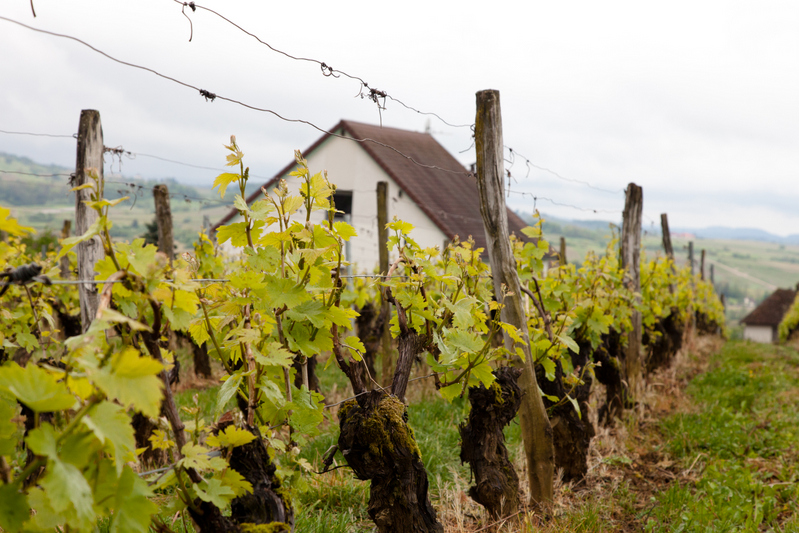
Jura vineyards
2. Vin jaune should spend at least five years under a film of yeast in the barrel and be bottled not earlier than in December in six full years following the harvest. Most often, the wine is poured into barrels for storing in spring or summer of the year following the harvest (thus, the wine rests for at least several months).
Vin jaune is aged in 228 liter oak barrels, where previously a different wine was already aged (new barrels would impart too much of oak to the wine). Barrels can be filled either full or 8-10 liters under-filled — it’s up to the winemakers to decide, and they take into consideration the temperature in the room where barrels are kept. As a rule, the warmer is the temperature, the fuller are the barrels. Barrels are set so, that they would not touch each other, on special supports. They are closed with plugs, but only so that foreign matter would not get into the wine, it is not done for sealing the wine.
A film, or veil, of yeasts forms on the surface of the wine within several weeks or month and can develop either naturally or with the help of inoculated (pure cultured) yeasts. The veil of yeasts on vin jaune consists of different forms of Sacharomices (as well as the flor on sherries) — but their exact species and quantitative composition is different from the sherry one and, of course, varies depending on the season and storage conditions. There are no standardized conditions for storing the wine and the veil formation in Jura. Barrels may be kept in cellars with more or less even temperature, or in attics with significant temperature fluctuations. In any case, the room for storing the wine must be well ventilated at a low humidity.
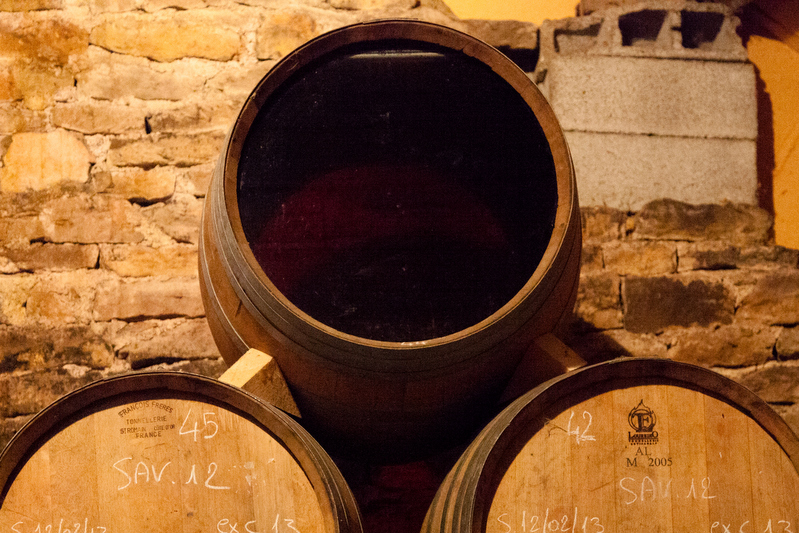
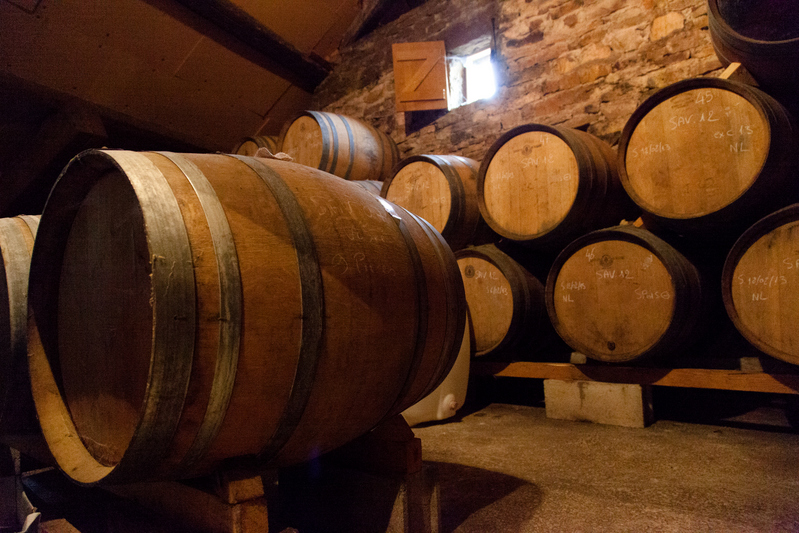
Vin jaune ageing. In one of the pictures one can see the veil, in the other one — a small window for ventilation
Just as the sherry flor, the veil protects the wine from oxidation and gives its taste and aroma some specific characteristics, which are mostly brought about by aldehydes generated by the yeasts.
The quality of vin jaune is controlled by Société de Viticulture du Jura; its experts examine the acidity of the wine and the changes in aldehydes content during the first years of ageing. Based on the results of these examinations some barrels can be withdrawn from the vin jaune production. Besides, the taste and aroma characteristics of the wine are evaluated prior to bottling.
After five years of ageing under a veil of yeasts, vin jaune is a dry wine of yellow (what a surprise:)) color, 13.5-15% abv, with 350-600 mg of acetaldehyde per liter, a specific flavour with characteristic notes of nuts and spices (a pleasant consequence of long ageing) and fresh taste with vivid and characteristic crisp finish (a not less pleasant consequence of the Savagnin character).
In this state the wine is bottled.
3. Vin jaune is bottled in containers of special shape and volume. They are called Clavelin and it’s easier to show their shape (see picture), than describe it. Such bottles were used for vin jaune in the 18th century already, and in 1914, one abbot ordered a batch this type of bottles with his name on them. And his name was Clavelin — this gave the name to the whole class of bottles. Buy the way, the batch of personalized bottles was only 30 items — a small price to go down in history.
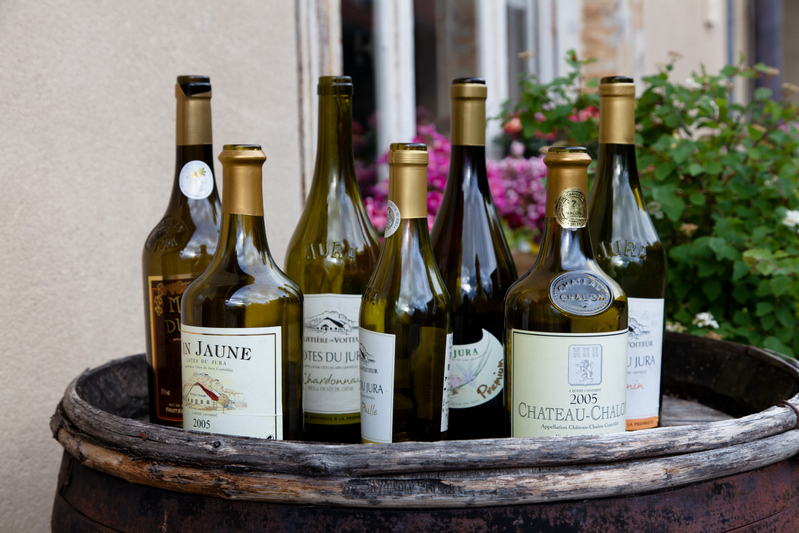
Clavelins are lower and wider than usual wine bottles
The Clavelin’s capacity is 650 ml, and it is filled with 620 ml wine, which is exactly the amount left after 1 liter of wine was aged for six years. The angel’s share, the Jura option. Sometimes vin jaune can be bottled in 375ml bottles. Formally, it is done for sales outside France, but in fact, such bottles can be easily obtained in Arbois itself.
4. Vin jaune shouldn’t go on sale earlier than January 1 of the seventh year after the harvest. So, it means that almost right after bottling it can appear in stores. Vin jaune continues developing in the bottle and some experts advise drinking it two years after the bottling. And bottling of vin jaune is associated with one event, whose mentioning would be a good transition from formal rules to informal impressions.
First weekend of February each year is a holiday in Arbois called Percée du Vin Jaune. It includes tastings, auctions, fancy-dress parades, and, of course, a solemn opening of a vin jaune barrel, and a non-less-solemn (so far as the pressure of the wine allows) filling of the first bottle of the year (relatively first, of course — for the holiday).
Certainly, Percée du Vin Jaune is the main event in Arbois. But even without this holiday, it’s very good in the town (or a large village — it has about 3500 inhabitants). There’s a lot of wine shops. As a matter of fact, most Jura wine is sold not simply in the domestic market but in a very domestic market, in Jura itself. Partly through the shops located in Arbois, which sell wine of a single producer each. And since there are many wineries in Arbois, single-brand stores are also numerous in Jura. It is great — although the absence of a regional enoteca surprises initially. However, there’s a Jura Vine and Wine Museum, which allows you to get a more or less complete picture of the region.
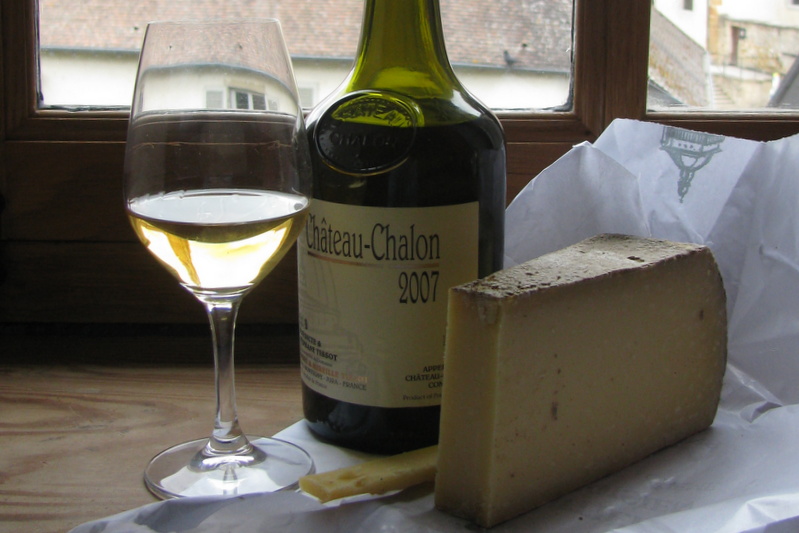
Vin jaune and Comté cheese. Picture by Olga Nikandrova
There excellent local cheeses in Arboir (as elsewhere in France, for that matter). A glass of vin jaune and a piece of Comté (with or without rind, it’s a matter of opinion) go miraculously well together. They also bake delicious bread there, work well with meat, make vinegar (including the one made from vin jaune) and rent out inexpensive apartments with very good kitchens. In short, there’s quite enough things to do in Arbois, at least for a week’s stay, and they’re very tasty.
Both Arbois and vin jaune played an important role in the life and work of Louis Pasteur — he went to college in Arbois and later devoted a prominent part of his studies to vin jaune in general and voile yeasts in particular. Now, there’s a statue of Pasteur in Arbois, and, generally, he is strongly remembered there.

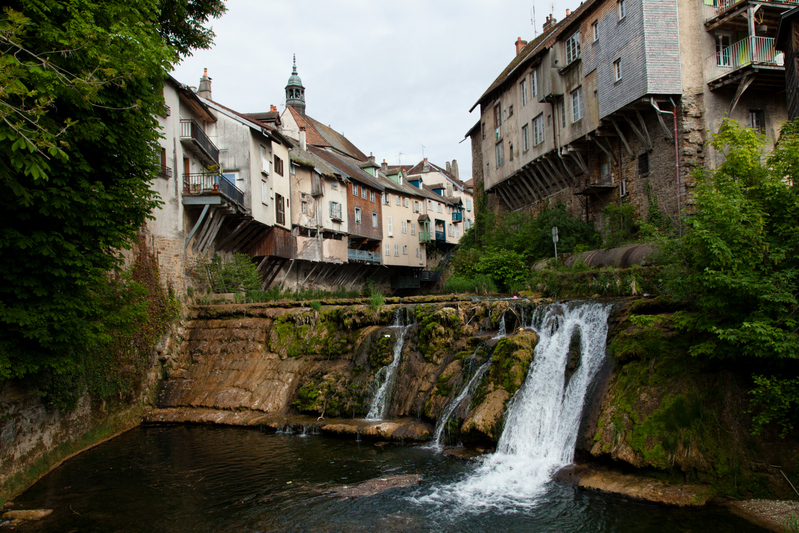
Arbois
In history of Arbois (and all Franche-Comté) there was a period of Spanish rule (in the 16th-17th centuries) — therefore the hypothesis of Spanish influence on the Jura wine culture is often articulated. Sometimes Savagnin grape is credited with Spanish origin. We cannot add anything to the subject matter and limit ourselves to mentioning the hypothesis.
And now — the most interesting.
The idea to compare vin jaune with Fino or Manzanilla in open tasting being theoretically attractive, appeared not very good practically — the drinks don’t go well together. And vin jaune is very different from biologically aged sherries.
Frankly speaking, this difference isn’t surprising. Vin jaune is made in different climate, from a different grape variety, aged non-dynamically, in different barrels, and is not fortified (in our opinion, it is the absence of fortification that determines the difference in the character of vin jaune and sherry more than anything else).
Vin jaune is very tasty wine, or rather very tasty wines, because there’s a number of them and they are different. Different terroirs, different vintages, different wineries — and a very wide flavor range, at the heart of which there’s always a fresh slightly sour note (close to apple mostly), spices, vanilla hints and perfect gastronomical properties. Vin jaune is best served at room temperature, although playing around and cooling the wine is also interesting.
Here’s a wonderful English web-site on vin jaune. And here’s a list of vins jaunes we’ve had an opportunity to drink (in Russian):
— André et Mireille Tissot Château Chalon 2007
— André et Mireille Tissot Vin Jaune 2007 «En Spois»
— André et Mireille Tissot Vin Jaune 2007 «La Vasée»
— André et Mireille Tissot Vin Jaune 2007 «Les Bruyères»
— Château l’Etoile Vin Jaune 2005
— Frédéric Lornet Arbois Vin Jaune 2004
And here are vins de voile (wines aged under a film of yeasts) from other regions of France — we do not have a stand-alone article about them, but they do exist, and we’ve tasted some of them:
— Mémoire d’Automnes
Warning!
This site can contain information about drinks excessive consumption of which may cause harm to health and is unadvisable for people who didn’t come of age.
Share Sherry
- Sherry.wine, FEDEJEREZ
- Copa Jerez, Sherry Week
- Sherry Notes, Jerez de Cine
- Los Generosos, Criadera
- Jerez-Xeres-Sherry
- Los Vinos de Jerez
Articles
- There are more articles in Russian than in English in this website. Sorry :(
Reviews
- To our great regret, we didn’t have time to translate tasting and traveling notes into English. But, if you want, you can see them in Russian.
